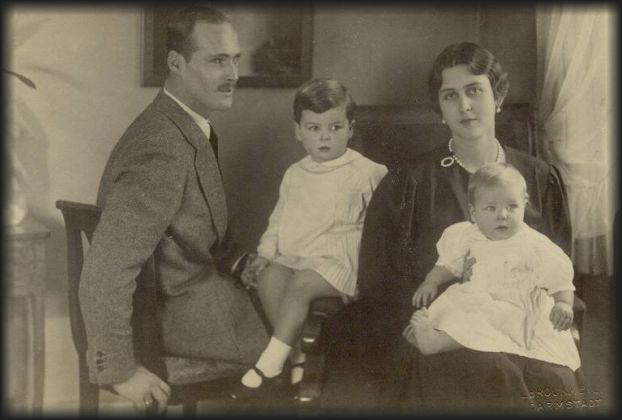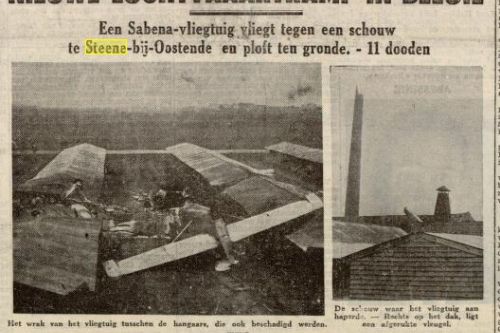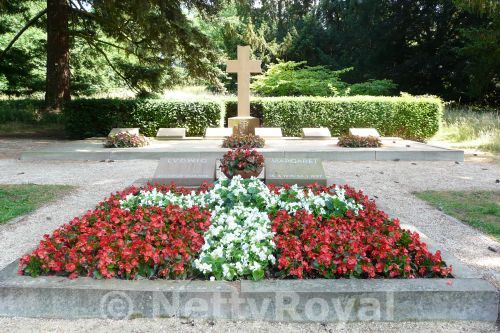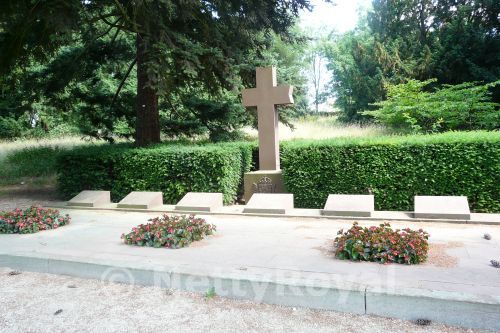In November 1937 a terrible tragedy shocked the royal families throughout Europe. On 9 October 1937 Grand Duke Ernst Ludwig von Hessen und bei Rhein (of Hesse and by Rhine), who had reigned until 1918, had died at the age of 68. Despite of that the family was to gather in London for the wedding of the Grand Duke’s second son, Prince Ludwig, and the Hon. Margaret Campbell Geddes. Instead of a happy occasion, the event turned into one of the saddest weddings ever.
On Tuesday 16 November 1937 the new head of the family, Georg Donatus, his pregnant wife Cecilie – a born Princess of Greece and Denmark, and sister to the Duke of Edinburgh – their two eldest children Ludwig and Alexander, the widowed Grand Duchess Eleonore – a born Princess zu Solms-Hohensolms-Lich -, the witness-to-be Joachim Riedesel Freiherr zu Eisenbach, Lina Hahn (nanny or lady-in-waiting to the Grand Duchess) and Arthur Martens (a gliding pioneer; most reports give Alfred Martens, it however seems to be Arthur Martens) at 1.03pm left München via Frankfurt (Belgian newspapers)/Cologne (Wikipedia), Germany, by plane. The expected arrival time in London was 4.10pm. The crew of the Sabena Airplane OO-AUB existed of pilot Antoine Lambotte, radio operator Maurits Courtois and mechanic Ivo Lansmans.
The airplane was to pick up two more passengers from Gent in Brussels, Belgium. However a thick fog made it too dangerous to land. They were ordered to fly to Oostende (Ostend), where the air was at the time clearer. The two passengers were to take the train to Oostende. Unfortunately when the airplane reached Oostende, the thick fog also had reached this coastal city. The pilot had to fly in circles above the airport of Steene near Oostende and had to search for the landing site. Then the fatal accident happened. At 2.40pm the airplane – a Junker 52 – hit the 65 Metres high chimneytop of the brickworks Briquetteries Nationales. One of the wings and the engine were ripped away and the airplane crashed and caught fire immediately.
The factory workers and others who had noticed the accident could do nothing for the people in the airplane. Only when the fire had been put out, the bodies of the people in the airplane could be recovered. Only the pilot could be identified quite easily. Georg Donatus was identified because of his wallet. Between the pieces of the wreckage also the head of a tiny baby was found, the doctor said it (apparently a son) must have been born during the crash, after a pregnancy of about eight months. It is not clear whether Cecilie had gone into labour already before the crash or during the crash. Also pieces of jewelry were recovered. The bodies were put into coffins and a funeral chapel was created in Hall 8 at the Civil Hospital in Oostende, where the coffins were standing in a row.
According to a local Belgian newspaper Prince Ludwig fainted when he heard about the accident at the airport in London, where he had been waiting for his family. It was decided that Ludwig and Margaret already would get married on 17 November, the day after the accident, instead of on 20 November. The wedding fully took place in private in St Peter’s Cathedral, Eaton Square, London. Afterwards the couple left for Oostende – they took the boat from Dover – where they were received by Mr Henri Baels, governor of the Province of West-Flanders [he in 1941 became the father-in-law of King Leopold III of the Belgians, when he married Baels daughter Lilian]. Ludwig and Margaret visited the place of the accident and greeted the coffins at the hospital. Quite a few important people did the same and laid wreaths at the coffins. At the Palace of Justice in Brugge Ludwig and Margaret identified the family jewelry, insured for three million Francs.
On Thursday afternoon the coffins were placed in a train. The three crew members were taken to Brussels, the eight (nine) passengers to Darmstadt, Germany, where they were buried. New flowers were placed on the coffins. Wreaths from Prince Baudouin and Princess Joséphine-Charlotte of Belgium were placed on the coffins of the little princes Ludwig and Alexander. Joachim Riedesel Freiherr zu Eisenbach was buried at the family vault in Sickendorf, Germany, on 22 November 1937.
Until the funeral the coffins of the members of the Grand Ducal family laid in state in the family mausoleum. On 23 November 1937 they were buried at the cemetery in the Rosenhöhe Park in Darmstadt. Many people said goodbye on the way to the burial place. Among the mourners were Lord Louis Mountbatten – representing the British King and Queen -, the Marchioness of Milford Haven – representing the British Queen Mary. Wreaths were sent by the Duchess of Kent, other British royals, the Emperor, Adolf Hitler and General Hermann Göring. The coffins were placed in a common grave, at its head a purple-draped altar and two burning candles. The army and the navy were represented and airplanes circled over the cemetery.
The only survivor of the small family of Georg Donatus and Cecilie was their fourteen-month-old daughter Johanna, who had been too young to come along to London. She had stayed at Wolfsgarten Castle, Germany, with her nanny. Ludwig and Margaret adopted her in 1938. Unfortunately the little Princess died of meningitis in 1939. Ludwig and Margaret would never have children of their own, and upon his death in 1968 the Hessen und bei Rhein branche of the family would become extinct. Margaret only died in 1997.
The six graves in a row are the ones of Grand Duke Ernst Ludwig (1868-1937), Grand Duchess Eleonore (1871-1937), Hereditary Grand Duke Georg Donatus (1906-1937), Hereditary Grand Duchess Cecilie (1911-1937), Prince Ludwig (1931-1937) and Prince Alexander (1933-1937). In the front are the graves of Prince Ludwig (1908-1968) and his wife Margaret (1913-1997).
Sources: De Halle of 21 & 28 November 1937, the Allgemeine Zeitung of 11 November 2017, FindAGrave, Wikipedia




